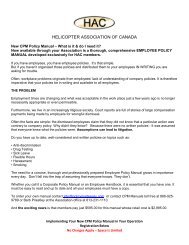HAC Oil & Gas IBP - Helicopter Association of Canada
HAC Oil & Gas IBP - Helicopter Association of Canada
HAC Oil & Gas IBP - Helicopter Association of Canada
You also want an ePaper? Increase the reach of your titles
YUMPU automatically turns print PDFs into web optimized ePapers that Google loves.
LINE HELIPADS IN DESERT AREASWhile the selection <strong>of</strong> a suitable landing area adjacent to the seismic line is unlikely to present greatproblems, precautions must be taken to prevent damage to helicopter engines and rotor blades due to sanderosion. Invariably, the helicopters will be specified with suitable sand reduction modifications. However,some preparation may be required at temporary landing sites; a simple remedy would be to suppress thesand with water.Note: Erosion <strong>of</strong> helicopter engine compressor turbine blades can be dramatic if suitable precautions are nottaken.LINE HELIPADS IN MOUNTAINOUS AREASSeismic parties in areas <strong>of</strong> mountainous terrain will <strong>of</strong>ten require the support <strong>of</strong> helicopters. Theperformance specification <strong>of</strong> the helicopters must be such that it is suitable for mountain operations.Mountain flying, particularly at high altitudes, presents a pilot with special problems, demanding a close study<strong>of</strong> the aircraft limitations and performance graphs and interpretation <strong>of</strong> local wind and turbulence effectscaused by topographical features.When undulations in the terrain are relatively smooth, or where the wind velocity is low, a laminar air flow canbe expected, giving a gentle up-draught on the windward slope <strong>of</strong> a hill or mountain and a correspondingdown-draught on the leeward side. Where the terrain contours are abrupt or jagged or the wind velocityhigh, the effects are less predictable, as a turbulent airflow will occur, both over and around the obstructions;whirls and eddies will produce local effect reversals <strong>of</strong> wind direction as well as vertical air currents.A phenomenon known as Standing Waves may occur when the wind direction is roughly perpendicular to amountain range, resulting in strong vertical air currents at intervals downwind <strong>of</strong> the range. To ensure thesafety <strong>of</strong> transit flights, it may be necessary for the pilot to select a route and altitude that would not appear tobe the most direct.Disorientation and a feeling <strong>of</strong> vertigo is a potential hazard <strong>of</strong> mountain flying where the route involves flightsover knife-edge ridges or approaches to pinnacles. Inexperienced pilots are prone to these effects whichonly serves to emphasize the need for selection <strong>of</strong> a suitably experienced operator.It should be anticipated that there will be occasions where the choice <strong>of</strong> the landing site will be dictated bytopographical features and therefore not ideally located on the line. It is essential that the helicopter operatorbe involved in the selection <strong>of</strong> landing sites.Hill-top and ridge locations may present obvious landing sites and are <strong>of</strong>ten selected. However, theselocations present their own problems due to turbulence, wind shear effect and inaccessibility due to lowcloud. Consideration should be given to the down-time due to these factors.When operating to any landing site in mountainous terrain, the pilot will require, at all times during theapproach and take-<strong>of</strong>f phase, an escape route to be flown in the event <strong>of</strong> encountering, for example, downdraughtingair. Time spent in planning the location <strong>of</strong> landing sites, preferably including an airborne survey,will rarely be wasted; locations can usually be found which fulfill the aviation safety requirements and involvethe minimum <strong>of</strong> rock and vegetation clearance. The helicopter pilot and or provider should be consultedduring Heli-pad constructionLINE HELIPADS IN FOREST OR JUNGLE AREASThe work involved in clearing trees, primary or secondary forest/jungle, even to 1m level is considerable andthe removal <strong>of</strong> tree trunks is unlikely to be achieved with the resources <strong>of</strong> a helicopter supported seismicparty. In order to achieve a flat area, clear <strong>of</strong> immediate obstructions allowing transition between the hoverand forward flight, it will <strong>of</strong>ten be convenient, especially in areas prone to flooding, to construct a raisedhelipad. However, the rate <strong>of</strong> decay and destruction by insects <strong>of</strong> s<strong>of</strong>twoods in tropical climates should notbe underestimated. Whenever raised wooden helipads are used, the following procedure is recommended:1. Upon first construction: Inspection and release to service by the senior pilot. (That will alsoinclude a check <strong>of</strong> the entire clearing for correct dimensions and freedom from obstructions).2. Two months from construction: Inspection by a ground party who may be brought in byhelicopter provided the pilot is briefed and able to keep the helicopter light on the undercarriage.Subject to findings during this check, the landing site may be released to service for a furthermonth.OGC <strong>IBP</strong> | Revision Date: Sept 2009 DRAFT61









